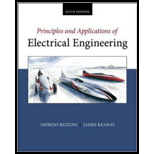
Concept explainers
Convert the rectangular factors to polar form and compute the product. Also compute the product directly using the rectangular factors. Compare the results.
a.
b.
Want to see the full answer?
Check out a sample textbook solution
Chapter 4 Solutions
Principles and Applications of Electrical Engineering
- The admittance of the impedance j12 is given by (a) j2S (b) j2S2 (c) j4Sarrow_forwardIn a series circuit of R = 15 Ω and L = 0.06 H, the voltage across the inductance is VL = 240sin (500t) V. Find the total voltage, current, the angle by which i lags VT and the magnitude of the impedance.arrow_forwarda. Apply a voltage of 120V at 60Hz to an impedance Z = 50 + 50j Ω as shown. b. Determine the value of C to bring the FP to 1 c. Tabulate the current in the source for different values of C d. Determine when the PF is lagging or leadingarrow_forward
- Reduce each of the following to rectangular form: a. Za = 5+j5+10∠30°; b. Zb = 5∠45°-j10; c. Zc = 10∠45°/3+j4; d. Zd = 15/5∠90°.arrow_forwardFind the total current to the parallel circuit of L = 45 mH and C = 400 µF with an applied voltage of v = 110sin(100t) V. Also, what is the total impedance, and power factor of the circuit? Is the circuit inductive or capacitive?arrow_forwardA series circuit has 50 ohm resistance, 2.22 microfarad capacitance and inductance of 8 mH. Find the total impedance at 796 Hz frequency. a. 50-j150 b. 50+j50 c. 50-j50 d. 50+j130arrow_forward
- Convert k = (1.55∠–18.7°) to rectangular form, (A + jB) Solve the real and imaginary partarrow_forwardThe power factor angle of a purely inductive circuit is 0 degrees Select one: True Falsearrow_forwardExpress each of these complex numbers in rectangular form and in exponential form: a. Za = 5∠45°; b. Zb = 10∠120°; c. Zc = -15∠-90°; d. Zd = -10∠60°.arrow_forward
- Given that: Rc=5.8 kohms Rs=1.8 kohms R1=80 kohms R2=10 kohmsarrow_forwardA resistor of 51.0 Q, an inductor of 22.0 pH and a capacitor of 150 pF are in parallel. The frequency is 1.00 MHz. Whatis the complex impedance, R_jX? A.51.0_j149. B.51.0_/149 C.46.2_j149. D.46.2_j14.9. ¥ Show Answer Answer: Darrow_forwardWhat impedance vector - j25 represents:A. A pure resistance. C. A pure capacitance.B. A pure inductance. D. An inductance combined with a resistance.arrow_forward
 Power System Analysis and Design (MindTap Course ...Electrical EngineeringISBN:9781305632134Author:J. Duncan Glover, Thomas Overbye, Mulukutla S. SarmaPublisher:Cengage Learning
Power System Analysis and Design (MindTap Course ...Electrical EngineeringISBN:9781305632134Author:J. Duncan Glover, Thomas Overbye, Mulukutla S. SarmaPublisher:Cengage Learning
